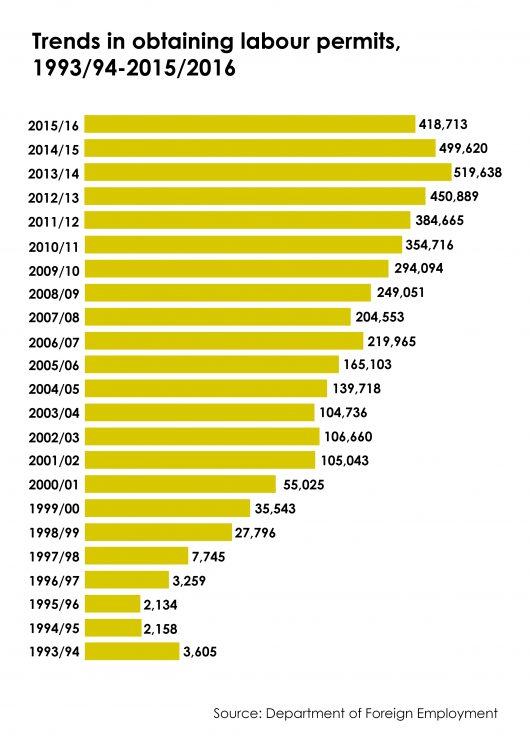Kamal Thapa misstates migrant worker numbers
Sujit Mainali / June 20, 2017

Graphic: Bikram Rai
Rastriya Prajatantra Party Chairman Kamal Thapa said the following in an interview aired on Sagarmatha TV on July 11, 2017:
Where are we today due to the policies and ideologies of the messengers of the political changes of 2006? Over 4 million Nepali youths have gone abroad due to lack of economic development in the country. During 2006 when the political movement started, the number of Nepali youths leaving the country was around 100,000 a year, but now, after 10 years, around 550,000 Nepalis have been leaving the country annually.”
South Asia Check has examined whether Thapa’s following two statements are fact-based or not:
First Statement: In 2006, around 100,000 Nepali youths used to go abroad for foreign employment per year.
Second Statement: Now 550,000 youths leave Nepal for foreign employment per year.
First Statement: In 2006, around 100,000 Nepali youths used to leave the country for foreign employment per year.
According to the Department of Foreign Employment, 204,553 Nepali left the country for foreign employment in 2006 (Governing Labor Migration in Nepal, Bandita Sijapati and Amrita Limbu, pg 15, Himal Books, Kathmandu).
The government does not maintain statistics of Nepali youths going to India for employment purpose and so the aforementioned figure does not include Nepali labor migration to India.
This shows, Thapa’s first statement is incorrect.
Second Statement: Now 550,000 youths leave Nepal for foreign employment per year.
According to a report of the Ministry of Labor and Employment, a total of 499,620 Nepalis left the country for foreign employment in the fiscal year 2014/15 (Labor Migration for Employment-A Status Report for Nepal: 2014/2015, Pg 7, Ministry of Labor and Employment).
According to the Department of Labor and Employment, 418,713 Nepali left the country as migrant workers in 2015/16 (Labor and Migration Bulletin, Editorial, No. 12). Massive earthquakes hit Nepal that year, which led to decline in labor migration from Nepal. The current fiscal year is still running so the annual statistics has yet to come.
Therefore, Thapa’s second statement appears to be slightly exaggerated.
This material is copyrighted but may be used for any purpose by giving due credit to southasiacheck.org.
Comments
Latest Stories
- In Public Interest Covid-19 cases are low, but that’s not an excuse to avoid vaccination
- In Public Interest What is BF.7, the sub-variant that has the world by its grip?
- In Public Interest Threat of a new Covid-19 wave looms large amid vaccine shortage in Nepal
- In Public Interest As cases decline, Covid-19 test centres in Kathmandu are desolate lot
- In Public Interest Dengue test fee disparity has patients wondering if they’re being cheated
- In Public Interest As dengue rages on, confusion galore about what it is and what its symptoms are. Here’s what you need to know
In Public Interest
 Covid-19 cases are low, but that’s not an excuse to avoid vaccination
The Pfizer-BioNTech bivalent vaccines authorised by the Nepal Government provide better protection a...
Read More
Covid-19 cases are low, but that’s not an excuse to avoid vaccination
The Pfizer-BioNTech bivalent vaccines authorised by the Nepal Government provide better protection a...
Read More
- What is BF.7, the sub-variant that has the world by its grip?
- Threat of a new Covid-19 wave looms large amid vaccine shortage in Nepal
- As cases decline, Covid-19 test centres in Kathmandu are desolate lot
- Dengue test fee disparity has patients wondering if they’re being cheated
- As dengue rages on, confusion galore about what it is and what its symptoms are. Here’s what you need to know